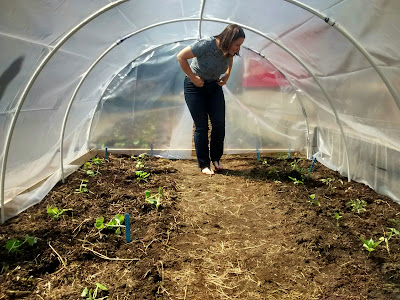The lower terrace is completely planted now.
Today we planted sunflowers along the north edge of the upper terrace.
Yesterday the students transplanted warms season crop... tomatoes, peppers, basil, cucumbers, squash, and even some tobacco. They erected a small high tunnel over a section of the warm season beds. We have the same crops growing inside and outside the tunnel, to allow some comparison of yield and disease pressure, but this won't be a randomized or replicated trial. Compost donated by Harvest Power is incorporated from the centre of the tunnel west, and compost donated by Net Zero compost is incorporated from the centre of the tunnel east.
The tunnel is just five feet tall. It consists of a 16-foot square of 6 mil UV-resistant plastic supported by five PVC hoops anchored by re-bar. Two more pieces of plastic form the end walls. Indoor weed management will require us to crouch a little. The site doesn't get much wind, so I hope it will hold up through the season.
The tunnel should help keep tomato leaves dry, to prevent late blight infection. I am very concerned about late blight now that our nights are warming up. We do not yet have a trickle irrigation systems set up, so we are still relying on sprinklers, which could contribute to prolonged periods of leaf wetness and greater risk of late blight infection.
We capped the pop-up sprinklers near the potatoes so that the water would go down into the soil, instead of up into the foliage.
The tunnel should help keep tomato leaves dry, to prevent late blight infection. I am very concerned about late blight now that our nights are warming up. We do not yet have a trickle irrigation systems set up, so we are still relying on sprinklers, which could contribute to prolonged periods of leaf wetness and greater risk of late blight infection.
We capped the pop-up sprinklers near the potatoes so that the water would go down into the soil, instead of up into the foliage.
Last week we received some donated tomato transplants from a student in our program. I brought them up to the lab that day, and back to my home on Saturday. That's when I started to see these water-soaked lesions with indistinct margins on the tomato leaves... a possible symptom of late blight. I disposed of the tomatoes, but put a few infected leaves in a sealed plastic freezer bag with a piece of damp tissue to promote sporulation. Twenty-four hours later I created a slides from the infected tissue for inspection under a compound microscope. Although I saw plenty of spores, I was glad that none had the characteristic lemon-shape that would confirm late blight.
The lettuce that we seeded on Thursday had emerged by yesterday. The row on the bottom in the image above was seeded with the Jang Seeder, and the row above was seeded with the Earthway. The thick rows in between the lettuce are purslane from the soil seedbank, which we left as a living mulch between the lettuce.
Our initial impression is that both seeders planted the lettuce seed too thickly, and there appear to be more bare patches in the row seeded by the Earthway. So soon after emergence, bare patches could be due to deeper seed placement, rather than lack of seed. We'll see if anything changes as the plants grow.
Yesterday the students harvested kale and spinach and pulled a row of spinach that was going to seed, replacing it with kale transplants.
Today we harvested our first peas.
The students filled in any holes in the Swiss chard rows of the compost rate trial with transplants, now that collection of emergence data is complete, and we don't expect further emergence.
Some of our beans are infested with black bean aphid, but they also support a strong population of lady beetles, which should help keep the aphid numbers in check. We're seeing lady beetle eggs, larvae, pupae, and adults.
The lupines and wildflowers are starting to bloom at the end of the terrace, providing nectar sources for beneficial insects, like the hoverflies that are plentiful in this area. They should also help with the aphids.

































